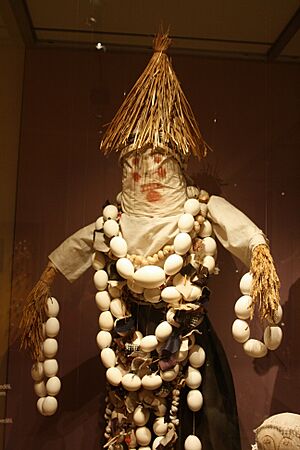Marzanna facts for kids


Marzanna is a special goddess from old Slavic stories. People in many countries like Poland, Russia, and the Czech Republic know her. She is known as the goddess of winter and death. But don't worry, she's not scary! She's part of an old tradition that helps people welcome spring.
Contents
Who is Marzanna?
Marzanna is a very old goddess from Slavic paganism. This was a religion practiced by Slavic people long ago. She is seen as the goddess of winter, cold, and even death. However, she is also linked to the idea of rebirth and the coming of spring. She represents the end of the cold, dark winter and the start of new life.
A Goddess with Many Names
Marzanna has many names depending on the country. In Poland, she is called Marzanna. People in Russia might call her Marena or Maslenitsa. In the Czech Republic, Bulgaria, and Slovenia, she is known as Morana. Slovaks might say Morena or Kyselica. In Macedonia, she is Morena. In Belarus and Ukraine, she is sometimes called Mara. These different names all refer to the same important goddess.
The Tradition of Drowning Marzanna
In many Slavic countries, there is a very old and popular tradition. People make a doll that looks like Marzanna. This doll is often made from straw and decorated with ribbons or old clothes. When spring is about to begin, usually around the Spring equinox (March 21st), people take the Marzanna doll to a river or lake.
The tradition involves throwing the doll into the water or sometimes burning it first. This act is a symbolic way of saying goodbye to winter. It's like sending away the cold, darkness, and sickness that winter might bring. By getting rid of Marzanna, people believe they are making way for spring to arrive.
Welcoming Spring with Gaik
After the Marzanna doll is sent away, people often return to their villages with something called a gaik. A gaik is a bouquet of green twigs, sometimes decorated with flowers or colorful eggs. It literally means "copse" or "small grove."
Bringing the gaik back to the village is a symbol of welcoming the new life of spring. It represents the warmth, green plants, and new growth that come with the warmer months. So, the whole tradition of Marzanna and gaik is a way for people to celebrate the changing seasons and the hope that spring brings. It shows how people long ago connected their lives to nature and its cycles.
Images for kids
See also
 In Spanish: Morana (diosa eslava) para niños
In Spanish: Morana (diosa eslava) para niños




